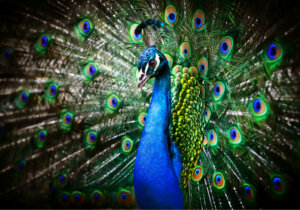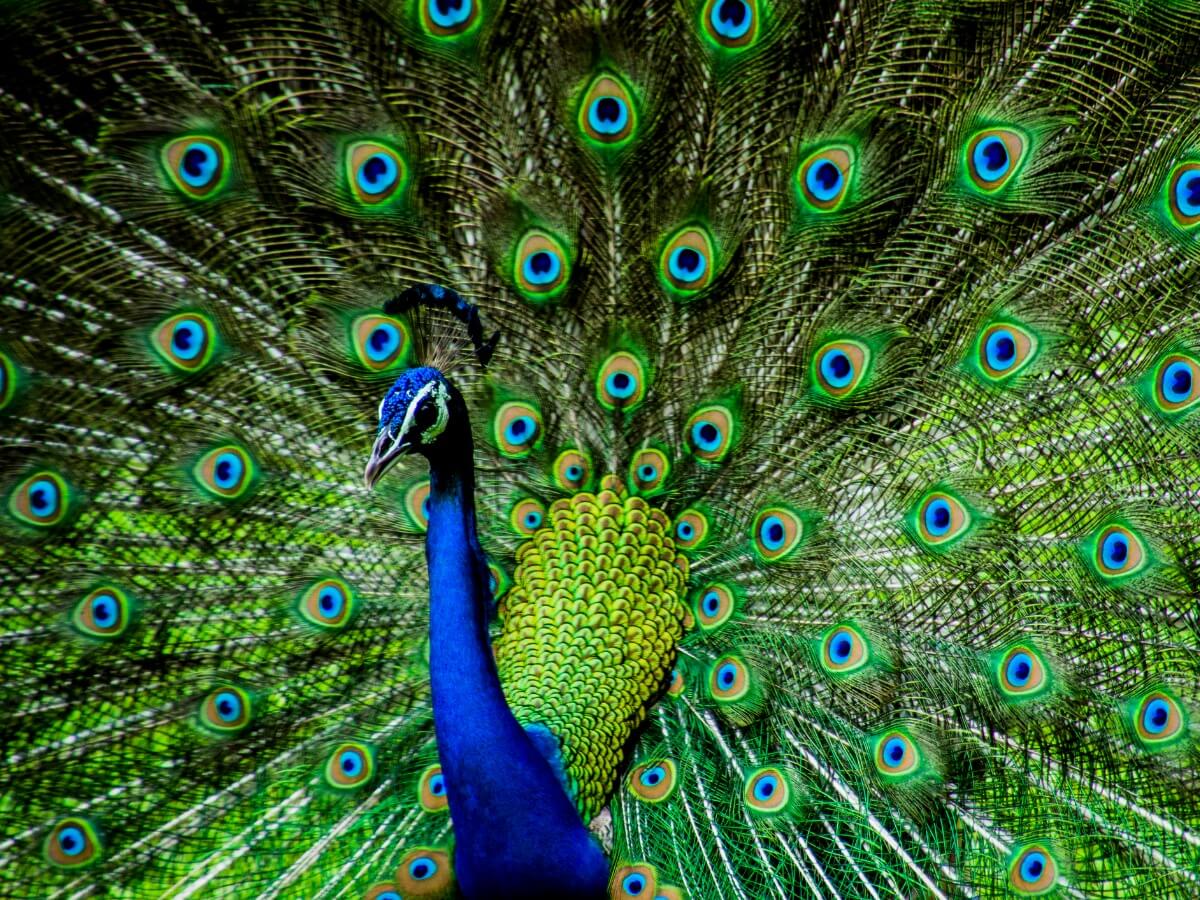Why the Peacock Spreads its Tail

The huge and beautiful peacock’s tail has been the subject of fascination among humans for centuries. Why such striking colors? Find out why the peacock spreads its tail.
While the female of this species is dedicated to raising chicks, the male needs to try to mate as many times as possible and can do it an average of 3 times per breeding season. If you want to know more about it, keep reading.
Sexual dimorphism
The peacock (Pavo cristatus) has one of the most striking sexual dimorphisms in the animal kingdom. While the male has brightly colored and metallic feathers and a long tail that it can fan out, the female has brownish duller tones, duller, with a long tail that it can’t extend.
The species that have such striking differences between the sexes tend to take advantage of the strategy of prioritizing the life of the female against possible attacks. In this way, the peacock can serve as bait to keep predators away from the nest, where the female hides with the young.

Reasons why the peacock spreads its tail
The tail of this bird is clearly uncomfortable, both for flying and for walking on the ground. So what good is it? There are two explanations for this, which you can read in the following lines.
Courtship
The specimen with the prettiest, neatest and colorful tail will, of course, be the one chosen to perpetuate its genes. During courtship, the male extends his tail, waves it, and directs it towards the female, to convince her that he’s the healthiest and most beautiful peacock around.
A recent hypothesis postulates that the function of the tail isn’t so relevant, as females don’t direct their gaze towards it too much during courtship. However, it seems that they have a great ability to perceive the contrast between the blue, green and black of the plumage of the male, so they direct their gaze to the whole show and not just to the tail.
Territoriality
When a male spreads its tail in front of another male, it’s usually a threat or a defense of the territory. In doing so, the peacock tries to appear bigger and stronger than its adversary in order to intimidate it. Just as the colors and the diameter of the extended tail serve to conquer the female, they also indicate health and strength against a competitor of the same species.
Curiosities about the peacock’s tail
By way of conclusion, here’s some additional information about this beautiful bird:
- The peacock’s tail consists of up to 150 feathers.
- Each of these feathers can measure up to 1.5 meters in length.
- The oval spots at the end of each feather are called ocelli, due to their similarity to the shape of an eye.
- The fibers of the tail feathers, unlike those of the rest of the body, have a structure that doesn’t make them suitable for flight, as their function is purely decorative.
- Recent studies revealed that males vibrate the small plume of feathers on their heads while waving their tails. Furthermore, the female appears to vibrate her own crown in response.

As you can see, something that, at first glance, doesn’t seem very compatible with survival may have its reasons. Although it seems cruel in human eyes that a member of the couple sacrifices itself in order to preserve its genes, it’s an effective technique to protect the offspring.
The huge and beautiful peacock’s tail has been the subject of fascination among humans for centuries. Why such striking colors? Find out why the peacock spreads its tail.
While the female of this species is dedicated to raising chicks, the male needs to try to mate as many times as possible and can do it an average of 3 times per breeding season. If you want to know more about it, keep reading.
Sexual dimorphism
The peacock (Pavo cristatus) has one of the most striking sexual dimorphisms in the animal kingdom. While the male has brightly colored and metallic feathers and a long tail that it can fan out, the female has brownish duller tones, duller, with a long tail that it can’t extend.
The species that have such striking differences between the sexes tend to take advantage of the strategy of prioritizing the life of the female against possible attacks. In this way, the peacock can serve as bait to keep predators away from the nest, where the female hides with the young.

Reasons why the peacock spreads its tail
The tail of this bird is clearly uncomfortable, both for flying and for walking on the ground. So what good is it? There are two explanations for this, which you can read in the following lines.
Courtship
The specimen with the prettiest, neatest and colorful tail will, of course, be the one chosen to perpetuate its genes. During courtship, the male extends his tail, waves it, and directs it towards the female, to convince her that he’s the healthiest and most beautiful peacock around.
A recent hypothesis postulates that the function of the tail isn’t so relevant, as females don’t direct their gaze towards it too much during courtship. However, it seems that they have a great ability to perceive the contrast between the blue, green and black of the plumage of the male, so they direct their gaze to the whole show and not just to the tail.
Territoriality
When a male spreads its tail in front of another male, it’s usually a threat or a defense of the territory. In doing so, the peacock tries to appear bigger and stronger than its adversary in order to intimidate it. Just as the colors and the diameter of the extended tail serve to conquer the female, they also indicate health and strength against a competitor of the same species.
Curiosities about the peacock’s tail
By way of conclusion, here’s some additional information about this beautiful bird:
- The peacock’s tail consists of up to 150 feathers.
- Each of these feathers can measure up to 1.5 meters in length.
- The oval spots at the end of each feather are called ocelli, due to their similarity to the shape of an eye.
- The fibers of the tail feathers, unlike those of the rest of the body, have a structure that doesn’t make them suitable for flight, as their function is purely decorative.
- Recent studies revealed that males vibrate the small plume of feathers on their heads while waving their tails. Furthermore, the female appears to vibrate her own crown in response.

As you can see, something that, at first glance, doesn’t seem very compatible with survival may have its reasons. Although it seems cruel in human eyes that a member of the couple sacrifices itself in order to preserve its genes, it’s an effective technique to protect the offspring.
All cited sources were thoroughly reviewed by our team to ensure their quality, reliability, currency, and validity. The bibliography of this article was considered reliable and of academic or scientific accuracy.
- Hart, N. S. (2002). Vision in the peafowl (Aves: Pavo cristatus). Journal of Experimental Biology, 205(24), 3925-3935.
- Indian peafowls’ crests are tuned to frequencies also used in social displays. (2018, 28 noviembre). EurekAlert! https://www.eurekalert.org/pub_releases/2018-11/p-ipc112118.php
- BirdLife International (BirdLife International). (2016, 1 octubre). Peacock (Pavo cristatus). IUCN Red List of Threatened Species. https://www.iucnredlist.org/species/22679435/92814454
This text is provided for informational purposes only and does not replace consultation with a professional. If in doubt, consult your specialist.








